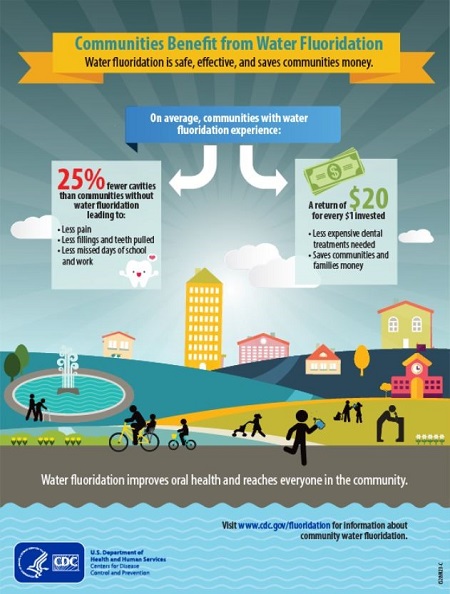Fluoride is naturally found in most all water sources, rivers, lakes, wells and even the oceans. For the past 75 years, fluoride has been added to public water supplies to bring fluoride levels up to the amount necessary to help prevent tooth decay.
Community water fluoridation is like drinking milk fortified with Vitamin D or eating bread and cereals enriched with folic acid. Before water fluoridation, children had about three times as many cavities. Because of the important role it has played in the reduction of tooth decay, the Centers for Disease Control and Prevention has proclaimed community water fluoridation one of ten great public health achievements of the 20th century. Studies prove water fluoridation continues to help prevent tooth decay by at least 25% in children and adults, even with fluoride available from other sources, such as toothpaste. Today, almost 75% of the U.S. population is served by fluoridated community water systems. In North Dakota, 96.5% of the total state population is served by fluoridated community water systems. Access data, infographics, and learn more about Basics of Community Water Fluoridation from the Centers for Disease Control and Prevention.
- If you are a healthcare professional, and interested in learning more about fluoride, access the Fact Sheet for Health Professionals, provided by the National Institutes of Health.
- If you are a consumer, interested in learning more about fluoride, access his Reader-Friendly Fact Sheet for Consumers, provided by the National Institutes of Health.

Drinking Water Program
The North Dakota Drinking Water Program (DWP) works with all public water systems in North Dakota to ensure that they provide safe drinking water and are meeting the requirements of the Safe Drinking Water Act.

Fluoridation Learning Online
Fluoridation Learning Online (FLO) is a free continuing education credit opportunity and resource offered by the Centers for Disease Control and Prevention (CDC). It is designed to build the capacity of water system operators and other related personnel by helping them increase their knowledge and refine their skills in implementing and maintaining community water fluoridation.

Fluoridation Facts
This product from the American Dental Association contains answers to frequently asked questions regarding community water fluoridation. The booklet contains information regarding the latest scientific research in an easy to use question and answer format to assist policy makers and the general public in making informed decisions about fluoridation.



